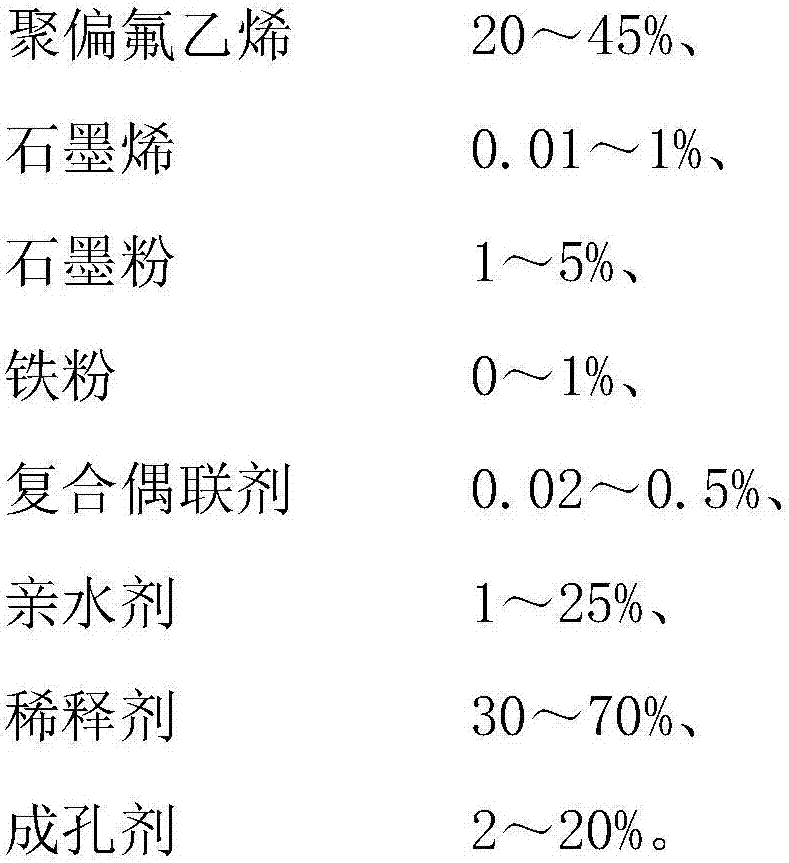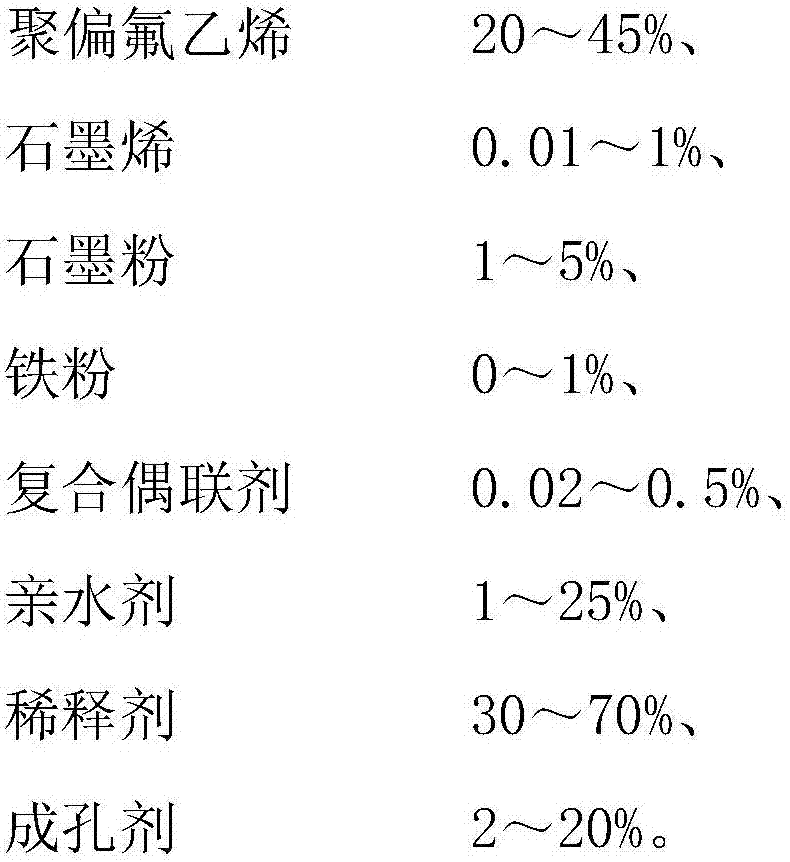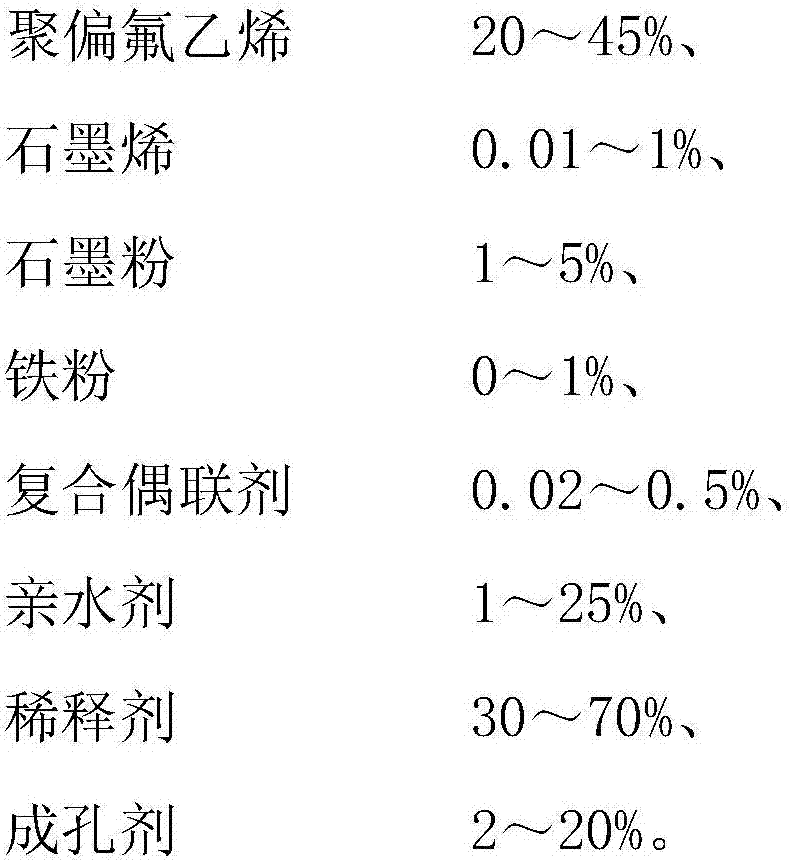Graphene modified polyvinylidene fluoride hollow fiber ultrafiltration membrane and preparation method thereof
A polyvinylidene fluoride, graphene modification technology, applied in ultrafiltration, separation methods, chemical instruments and methods, etc.
- Summary
- Abstract
- Description
- Claims
- Application Information
AI Technical Summary
Problems solved by technology
Method used
Image
Examples
preparation example Construction
[0025] A preparation method of a graphene-modified polyvinylidene fluoride hollow fiber ultrafiltration membrane, the specific steps are:
[0026] In order to effectively disperse graphene in polyvinylidene fluoride and to reduce costs, firstly, 0.01-1% graphene and 1-5% graphite powder are pre-mixed and microwave-dried, and then 0.02-0.5 % composite coupling agent, 0-1% iron powder, 20-45% polyvinylidene fluoride, mixed at high speed;
[0027] Add 1-25% of hydrophilic agent, 2-20% of pore-forming agent, and 30-70% of diluent in sequence to the above-mentioned high-speed mixed ingredients, and mix evenly to make a film-making material;
[0028] The hollow fiber ultrafiltration membrane is prepared by the thermal phase method, and the membrane material is poured into a twin-screw extruder at 200-400 ° C to heat it to a molten state; the melted membrane material passes through the hollow fiber membrane die After extrusion, it is cooled into a hollow fiber tube;
[0029] Pass c...
Embodiment 1
[0039] Pre-mix 0.2% graphene and 5% graphite powder and microwave dry, then add 0.5% composite coupling agent, 0% iron powder, 20% polyvinylidene fluoride, and mix at high speed;
[0040] Add 10% hydrophilic agent, 2% pore forming agent, and 30-62.3% diluent in sequence to the above-mentioned high-speed mixed ingredients, and mix evenly to make a film-making material;
[0041] Pour the film-making material into a twin-screw extruder at 200°C and heat it to a molten state; the melted film-making material is extruded through the hollow fiber membrane die and cooled to form a hollow fiber tube;
[0042] Pass compressed air or high-boiling-point non-solvent into the hollow fiber tube as the core liquid, and then send the hollow fiber tube into a gas-phase or liquid-phase separation tank to separate the diluent and pore-forming agent in the film-making material to obtain graphene Modified polyvinylidene fluoride hollow fiber ultrafiltration membrane.
[0043] The outer diameter of...
Embodiment 2
[0045] Pre-mix 1% graphene and 2% graphite powder and microwave dry, then add 0.15% composite coupling agent, 0.5% iron powder, 45% polyvinylidene fluoride, and mix at high speed;
[0046] Add 5% of hydrophilic agent, 16.35% of pore forming agent, and 30% of diluent in sequence to the above-mentioned high-speed mixed ingredients, and mix evenly to make a film-making material;
[0047] Pour the film-making material into a twin-screw extruder at 400°C and heat it to a molten state; the melted film-making material is extruded through the hollow fiber membrane die and cooled to form a hollow fiber tube;
[0048] Pass compressed air or high-boiling-point non-solvent into the hollow fiber tube as the core liquid, and then send the hollow fiber tube into a gas-phase or liquid-phase separation tank to separate the diluent and pore-forming agent in the film-making material to obtain graphene Modified polyvinylidene fluoride hollow fiber ultrafiltration membrane.
[0049] The outer dia...
PUM
| Property | Measurement | Unit |
|---|---|---|
| Outer diameter | aaaaa | aaaaa |
| The inside diameter of | aaaaa | aaaaa |
| Separation aperture | aaaaa | aaaaa |
Abstract
Description
Claims
Application Information
 Login to View More
Login to View More - R&D
- Intellectual Property
- Life Sciences
- Materials
- Tech Scout
- Unparalleled Data Quality
- Higher Quality Content
- 60% Fewer Hallucinations
Browse by: Latest US Patents, China's latest patents, Technical Efficacy Thesaurus, Application Domain, Technology Topic, Popular Technical Reports.
© 2025 PatSnap. All rights reserved.Legal|Privacy policy|Modern Slavery Act Transparency Statement|Sitemap|About US| Contact US: help@patsnap.com



